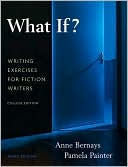

 |

|

The average rating for What If? Writing Exercises for Fiction Writers based on 2 reviews is 3 stars.
Review # 1 was written on 2009-06-26 00:00:00 Dave French Dave FrenchThis second edition of What if?, a tome of a book, is labeled "College Edition" and would appeal to anyone teaching fiction writing, or to anyone who writes fiction. This book would also appeal to readers: the final two sections - 200 pages of this over-500-page book - contain a dozen short-short stories; and a collection of contemporary short stories by stellar authors such as Margaret Atwood, Raymond Carver, and Alice Munro. The book is organized around fourteen topics: Beginnings; Notebooks, Journals and Memory; Characterization; Perspective, Distance and Point of View; Dialogue; The Interior Landscape of Your Characters; Plot; The Elements of Style; A Writer's Tools; Invention and Transformation; Revision: Rewriting is Writing; Games; Learning from the Greats; and Sudden, Flash, and Microfiction: Writing the Short Short Story. Although I am presently working on the second draft of a novel, I still do some of the exercises now and then, and have ended up with some surprising results. What If? is actually more like a textbook: Each exercise consists of an introductory paragraph, instructions for completing the exercise, a paragraph explaining its objectives, and finally, in some, but not all cases, an example executed by a student. By breaking down the exercises into their constitutional parts, we ensure that student and teacher understand both the rational behind the task and the method by which to complete it. … Included, are many exercises by fiction writers who are also teachers. In the introduction, the authors quote what Angus Wilson had to say in a Paris Review interview: "Plays and short stories are similar in that both start when all but the action is finished." This goes along with Horace's injunction to begin the story in medias res - in the middle of things. In The Exercise: "Consider how many of the opening lines below pull you into the center of the story. What do you know about the story - situation, characters, geography, setting, class, education, potential conflict, etc. - from reading the titles in the opening lines? What decisions has the author already made about point of view, distance, setting, tone, etc.? Notice how many of the titles are directly related to the first line of the story: "The Lady with the Dog" by Anton Chekhov They were saying a new face had been seen on the esplanade: a lady with a pet dog. "Medley" by Toni Cade Bambara I could tell the minute I got in the door and dropped my bag, I wasn't staying. "Bigfoot Stole My Wife" by Ron Carlson The problem is credibility. "Jump-up-Day" by Barbara Kingsolver Jericha believed herself already an orphan - her mother was in the ground by the time she could walk on it - so the loss of her father when it came was not an exceptional thing. These are only a few of the examples given, and they are followed up by student examples. The Objective: "To cultivate the habit of beginning your stories in the middle of things. Because you are not obligated to finish these stories, this exercise lowers the emotional stakes and helps to shake up and surprise the imagination." And, if you write reviews, you might find the following "exercise" especially helpful: In Learning from the Greats - What Keeps You Reading?: "In The Eye of the Story, Eudora Welty writes, 'Learning to write may be part of learning to read. For all I know, writing comes out of a superior devotion to reading.' Part of the apprenticeship of being a successful writer is learning to read like a writer, discovering how a particular story catches your attention and keeps you involved straight through to the end. The Exercise: Half-way through a story, ask yourself several questions. What do I care about? What has set in motion that I want to see completed? Where is the writer taking me? Then finish reading the story and see how well the writer met the expectations that she raised for you. The Objective: To illustrate how the best stories and novels set up situations that are resolved by the time you finish the story or close the book. To learn how to arouse the reader's curiosity or create expectations in the first half of your story or novel, and then to decide to what degree you should feel obliged to meet those expectations." This is a book for a writer at any level. If you use this book, your writing will definitely improve. And if you are "just" a reader, you may well find a new level of appreciation for the writing that you choose to read. There is something in it for everyone. |
Review # 2 was written on 2018-01-24 00:00:00 Melissa Archilla Melissa ArchillaDNF on account of content. What's wrong here, folks? How hard is it to write a clean writing exercise book?? Good grief. Sad, too, because some of the exercises were interesting. #nope |
CAN'T FIND WHAT YOU'RE LOOKING FOR? CLICK HERE!!!